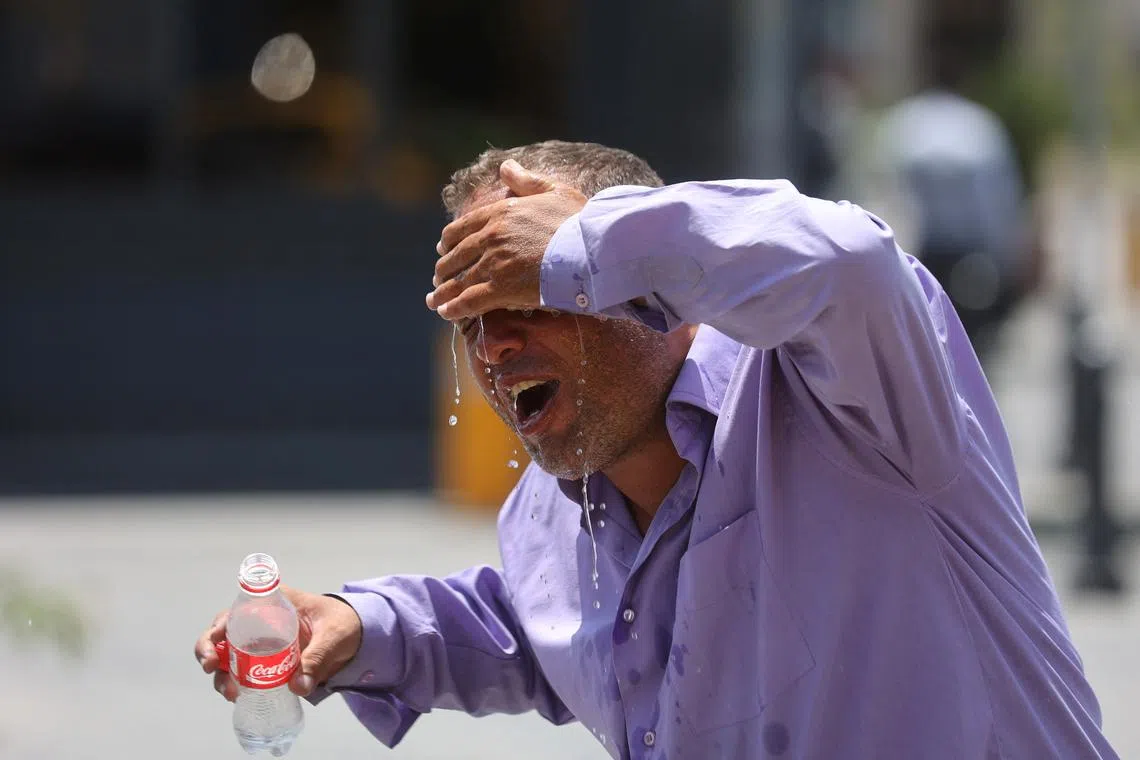Extreme heat is making our mental health worse
Sign up now: Get ST's newsletters delivered to your inbox

Extreme heat can make it harder to think clearly and be productive at work, and exacerbates common mood disorders.
PHOTO: REUTERS
Follow topic:
On July 22, planet earth achieved a terrifying milestone: Global temperatures reached their highest level in recorded history
By now, most of us understand that extreme heat is bad for our health, making our hearts, lungs, kidneys and other organs work much harder. But too often we overlook the quieter, less obvious toll heat takes
Extreme heat does not just make us cranky and uncomfortable; it can make it harder to think clearly and be productive at work. It also worsens our mental health, exacerbating common mood disorders such as anxiety and depression as well as rarer conditions like schizophrenia and self-harming. With each warming year, that issue deserves more time and attention.
Typically, a part of our brain called the hypothalamus keeps our body at its natural internal temperature (for most, that is around 37 deg C). But the human brain has only so much energy to devote to that, explained Dr Kim Meidenbauer, a social, cognitive and environmental neuroscientist at Washington State University.
On an oppressively hot day, “one of the first things that seems to go is higher cognitive functioning”, she said. This makes it harder to pay attention and impairs working memory (humans’ ability to process and keep track of information in real time).
For some, that cost is high. The elderly, young children, people taking certain medicines for schizophrenia or depression, and those with certain medical conditions or disabilities have a harder time thermoregulating.
One analysis of commercial health insurance claims over the course of a decade linked hotter days to an increase in emergency room visits associated with a broad array of mental health conditions.
The rate of visits to the emergency room was higher in northern parts of the US, suggesting the need for cities in those areas to better adapt their infrastructure to help people when temperatures soar, said Assistant Professor Amruta Nori-Sarma of the Environmental Health Department at Boston University School of Public Health, who led the work. Understanding what is driving those visits – and who is at most risk – is critical for preparation and prevention.
Heatwaves have also been linked to a higher risk of suicidality.
And people with schizophrenia are disproportionately at risk of succumbing to the effects of extreme heat. Some 8 per cent of the deaths that occurred during the 2021 heat dome in British Columbia, Canada, were among people with schizophrenia, a group that comprises less than 1 per cent of the population there.
Dr Liv Yoon, a sociologist at the University of British Columbia, Vancouver, has been trying to diagnose the complex causes of those deaths. Multiple factors are at work, including both physiological deficits and social vulnerabilities, she said.
A symptom of schizophrenia is an unawareness of one’s bodily status – it is hard to tell how hot or cold you are. Moreover, people with schizophrenia are often taking medication that can compromise the body’s ability to thermoregulate.
What is the solution? Reducing the mental health impact of climate change will require some obvious structural fixes, whether that is policy aimed at slowing global warming, addressing social determinants of health, or improvements in the design of cities to minimise dangerous hot spots.
Hospitals need to know when to expect an influx of patients, and at the same time, more needs to be done to reduce demand, both by addressing mental health needs before someone reaches the point of a crisis and ensuring people have access to resources amid a heatwave. That is especially true for people with schizophrenia, who might be less likely to take advantage of public resources like cooling centres.
Many small changes can be made now. For example, training the mental health workforce to be more aware of heat’s dangers could encourage them to check in on the most vulnerable, connect patients with more resources, and make sure they know when their medicines put them at higher risk when temperatures rise.
We all can make a difference, too. “More and more research is finding that social isolation is a huge factor” in predicting someone’s risks amid extreme heat, said Dr Yoon. The city of Vancouver has been promoting “cool kits”, physical bags of items that can help people stay safe in the heat. But increasingly, she said, public health officials are recognising that social connections matter just as much.
Whether or not someone leans on their community is one of the best predictors of resilience, Dr Nori-Sarma said. “Those social ties are often the most protective measures we have in place.”
Checking in on friends, tuning into the family text chain, keeping an eye out for your neighbours who live alone – those small acts can have a big impact on our most vulnerable members of society.
As this scorching hot summer drags on, that is worth remembering. BLOOMBERG

